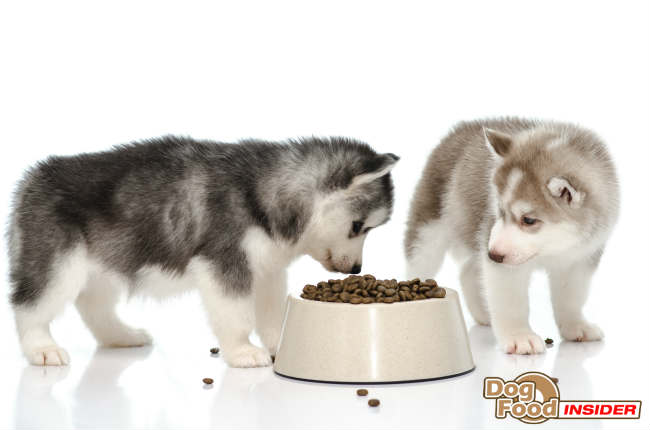
To learn about dog food digestion, we first have to look at the Timber Wolf, also known as the Gray Wolf. Dogs share 99 percent of their DNA with the Timber Wolf and, as such, their digestive system is nearly identical. Many people believe that dogs are omnivores since they eat both plant- and meat-based foods. However, dogs are actually classified as carnivores.
Dogs Are Carnivores
Carnivores are also known as meat-eaters. This term describes animals who have a diet consisting mainly of meat, whether through predation or scavenging, which includes dogs. While your dog may enjoy eating fruits, vegetables, and other non-meat-based foods, their anatomical makeup shows that they evolved as a carnivore. To help explain your dog’s food digestion process, here are some of the carnivore features you will find in any household dog:
Digestive Tract: With short and acidic digestive tracts, dogs are able to digest animal fat very quickly. Plant matter takes longer to break down which is why herbivores (animals that eat plant matter such as cows) have long digestive tracts. Dogs also secrete large amounts of hydrochloric acid, further assisting in the breakdown of meats as well as helping to kill bacteria found in raw meat.
- Teeth: Carnivore teeth, including dog teeth, are sharp and pointed as they are designed to slice through and penetrate tough raw meat. Teeth are also elongated which makes catching and killing prey much easier. By comparison, herbivores have teeth designed for grinding plant matter.
- Jaws: The jaws of a carnivore move vertically in a chomping motion. This allows a dog to slice through meat. Dogs also have the ability to open their mouths and throats widely which enables them to swallow large chunks of meat and fat rapidly.
- Saliva: The saliva of a carnivore contains no Amylase which is an enzyme that breaks down starch (carbohydrates) into sugars. Only the pancreas produces Amylase which makes a high carbohydrate diet a poor choice for carnivores, including dogs, as it puts extra strain on the digestive system. Unfortunately, many dog food brands are high in carbohydrates. You also may have noticed that your dog doesn’t chew his or her food as much as you’d expect. That’s because carnivores don’t need to mix food with saliva for proper digestion like herbivores and omnivores do. Carnivores simply bite off the largest amount of meat or fat they possibly can and swallow it whole.
Alright, so we’ve determined that your dog is a carnivore. That’s a good starting point! However, even Timber Wolves enjoy fruits and vegetables when they find them. They also eat non-meat food when they eat the stomach contents of their prey, for example, which often consists of partially-digested plant matter. (Wolves eat birds, deer, caribou, and smaller animals when they catch them.) The stomach and its contents are considered a rich prize for a wolf. Wolves are also not averse to scavenging for food when they are hungry or if finding food is easier than hunting prey. Scientists believe that wolves were probably first domesticated and developed into dogs because the wolves were scavenging around early human camps, drawn by the smell of food. So, while your dog evolved as a carnivore, he has been domesticated for at least 15,000 years and shared his diet with humans for millennia. Dogs are happy to have small amounts of fruit, vegetables, and other non-meat foods added to their diet and these foods can be quite beneficial to your dog. You will find them mixed into many high quality dog foods.
Now, let’s take a look at what your dog really needs for appropriate dog food digestion.
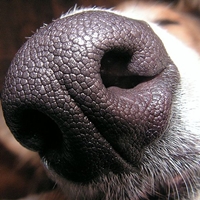 Protein is the essential ingredient that leads to healthy dog food digestion. Proteins help with basic body functions including cellular regeneration, tissue maintenance, hormone and enzyme production, and it assists in generating healthy energy. With this in mind, not all proteins are created equal. Factors affecting the quality of proteins include the source and the digestibility of proteins for a dog.
Protein is the essential ingredient that leads to healthy dog food digestion. Proteins help with basic body functions including cellular regeneration, tissue maintenance, hormone and enzyme production, and it assists in generating healthy energy. With this in mind, not all proteins are created equal. Factors affecting the quality of proteins include the source and the digestibility of proteins for a dog.
Source Of Proteins
Meat-based proteins, also called animal proteins, have an amino acid profile that is considered to be a complete protein for dogs. On the flip side, plant proteins are considered to be incomplete as the amino acid profile does not fulfill the daily requirements a dog needs for optimal health. So not only are proteins important, but the proteins you feed your dog should largely be animal-based instead of plant-based. Many dog food companies use a large amount of plant-based protein which can create problems for your dog’s digestive system. Plant proteins also lack certain acids which are necessary for healthy growth and development. Most cheaper kibble contains large amounts of corn gluten, soybean meal, and other plant-based material which is harder for your dog to digest than animal-based proteins.
Digestibility Of Proteins
Plant matter takes longer to digest than meat-based proteins, which is why omnivores and herbivores have longer digestive tracts. Since dogs are carnivores, they have very short digestive tracts. Under most circumstances, dogs are not able to digest plant-based proteins efficiently and do not derive as much nutrition from them as they need. Animal meat, on the other hand, is not only high in protein, it is relatively easy for dogs to digest. Therefore, dog food with a higher meat protein content is usually better. If the first ingredient in your dog’s food is not a meat protein, you should seriously consider switching to a brand with a higher meat content. Check out my dog food reviews to find a brand that contains a higher meat content.
Varying Qualities Of Meat Proteins
Even among meat proteins, some proteins are easier to digest than others. Muscle meats such as chicken, beef, and lamb are usually rated at around 92 percent digestibility. Organ meats (kidney, liver, heart) are rated at 90 percent digestibility. Fish is rated at about 75 percent digestibility. By contrast, eggs are considered to have protein that is 100 percent digestible. Plant sources of protein, such as soy, rice, oats, wheat, and corn, have protein digestibility between 75 and 54 percent. This means that when you read the dog food label, even if two foods have the same protein percentage, your dog may be able to digest one food better than the other and thus get better nutrition.
 As humans, we like to stay away from animal fat so we can look better wearing our speedos and string bikinis at the beach. However, animal fat is crucially important for proper dog food digestion. Dogs do not suffer from heart disease or cholesterol problems caused by high levels of animal fat. Animal fat should not be avoided when feeding your dog as it is crucial to having a healthy dog. Oh, and it makes for a softer and shinier coat, too!
As humans, we like to stay away from animal fat so we can look better wearing our speedos and string bikinis at the beach. However, animal fat is crucially important for proper dog food digestion. Dogs do not suffer from heart disease or cholesterol problems caused by high levels of animal fat. Animal fat should not be avoided when feeding your dog as it is crucial to having a healthy dog. Oh, and it makes for a softer and shinier coat, too!
When reading the ingredient list on dog food packaging, make sure fat is listed from a specific source such as chicken fat. Anything listed as animal fat is very vague and can include used restaurant fat or other fat sources with all the nutrients already cooked out. The vague “animal fat” can be a mixture of fats from unnamed, less desirable meat sources and not something that you want to feed your dog.
What Does Animal Fat Do For Dogs?
In short, it gives them healthy energy! Since household (non-working) dogs are such couch potatoes and spend a lot of time resting as compared to their ancestors (the Timber Wolf), they don’t require quite as much fat and protein in their diet as a wolf does. A good range of animal fat in dog food is about 15 percent to 20 percent. If the food meets AAFCO’s (Association of American Feed Control Official) minimum requirements for food labeling (and you should not buy a food which does not meet these minimum requirements), it will show a guaranteed analysis on the label. This analysis will provide the percentage of each of the nutrients in the food, including the minimum percent of crude protein and crude fat, and the maximum percent of crude fiber and moisture. (“Crude” refers to a testing method used and is not a comment on the ingredients.) This information should always be found on the dog food label. If you have any questions about the analysis, most companies also provide this information on their company web site. The fat percentage given in the analysis is included in the food. It does not cook off during the preparation of the food.
Finally, dogs require what are known as essential fatty acids which a dog is unable to naturally produce. The only way a dog can acquire essential fatty acids is to consume them, and they are mostly found in meat or fish-based food. The most important of all the essential fatty acids includes DHA and EPA (Omega-3) as well as Linoleic and Arachidonic (Omega-6). It is very important that there is a good balance between Omega-3 and Omega-6. Some dog food brands include these essential fatty acids. I’ll once again shamelessly link to my dog food reviews to help you sort out the good brands from the bad. The reason why essential fatty acids are important with regard to the fat in your dog’s diet is that without the fat, your dog is not able to consume or digest these fatty acids. In addition, there are a number of vitamins that your dog needs which are only soluble in fat. Without good sources of fat in his food, your dog won’t be able to metabolize the vitamins he needs for good health.
Sources For Omega-3
So where does Omega-3 come from? Well, the best source for a dog is in fish. Fish is high in what is known as EPA or Epicosapentaenoic Acid (try saying that 5 times fast!). EPA is a requirement for a healthy dog. Fish also contains DHA or Docosahexaenoic Acid (I’m not making these words up, honest!). Plants, on the other hand, contain ALA or Alpha-Linolenic Acid. While ALA is a form of Omega 3, it is not a requirement for dogs! So once again, a high meat-based food, perhaps mixed with some Omega-3 from fish, should lead to healthier digestion.
 Although it’s true that the ancestors of our modern dogs didn’t eat grain (modern agricultural grains didn’t exist 15,000 years ago), many dog foods today include grains in their ingredients. Contrary to popular belief, this is not done merely to add a cheap filler to food. Grains such as corn, wheat, rice, and others do add plant protein to a dog’s diet. And, in the case of corn, this is no longer a cheaper source of protein. Crop prices for corn to feed cows for milk, cattle for beef, and to provide ethanol for our vehicles are constantly rising which partly explains the rising cost of dog food, along with transportation costs related to the price of gasoline. In other words, corn is no longer cheap. If you feed a dog food that contains corn, you may find that the dog food manufacturer is making changes to utilize some other plant proteins such as peas or soybeans that cost them less.
Although it’s true that the ancestors of our modern dogs didn’t eat grain (modern agricultural grains didn’t exist 15,000 years ago), many dog foods today include grains in their ingredients. Contrary to popular belief, this is not done merely to add a cheap filler to food. Grains such as corn, wheat, rice, and others do add plant protein to a dog’s diet. And, in the case of corn, this is no longer a cheaper source of protein. Crop prices for corn to feed cows for milk, cattle for beef, and to provide ethanol for our vehicles are constantly rising which partly explains the rising cost of dog food, along with transportation costs related to the price of gasoline. In other words, corn is no longer cheap. If you feed a dog food that contains corn, you may find that the dog food manufacturer is making changes to utilize some other plant proteins such as peas or soybeans that cost them less.
Overview Of Plant Based Proteins
As already discussed, plant proteins are not as easy for a dog to digest as meat proteins, but they are not quite the garbage that they have been labeled in some quarters. Although some people have advocated that you should not feed your dog any grains at all, there are no scientific studies that show feeding a grain-free diet is healthier for a typical dog. If your dog has any kind of allergy or food intolerance to a grain they you should obviously avoid feeding a food with that grain. Otherwise, there is no proven health reason to avoid grains in your dog’s food. Some people have suggested that feeding dog food containing grain can lead to obesity in dogs, but obesity in dogs depends on over feeding and lack of exercise. Dogs can become overweight eating any kind of food if they are not fed in moderation. Always measure your dog’s food and monitor his intake, no matter what kind of food you feed.
Is Grain Free Dog Food Healthier?
Although there is no evidence that a grain-free diet is healthier for your dog, many dog food companies today have been happy to hop on the band wagon and they are making grain-free diets for dogs, as well as Limited Ingredient Diets for dogs with allergies or food intolerances, and other special diets. Anyone can feed these diets but if you feed such a diet for your dog, be sure to pay attention to your dog’s condition. Is he gaining or losing weight? Does his coat look good? Does he look and act healthy? Does he have good energy? And, of course, what does his poop look like? This last question is important because if your dog is digesting the food well, he should produce small, compact stools. If he is not digesting the food well, you will probably see signs of diarrhea or cow plop-style poops meaning that the food is passing through his digestive system largely undigested. No matter how good your intentions or how much you are spending on the food, if your dog isn’t doing well on it, get rid of it. Go back to something your dog was eating that agreed with him, even if it was not as highly regarded.
There’s More To High Quality Dog Food Than Ingredients
In many cases there are also intangibles with dog food that are hard to measure in the guaranteed analysis or even the ingredient list. A company’s reputation, their quality control, and other matters can have an important impact on your dog’s nutrition. Sometimes you don’t know when a respected company has been purchased by a lesser manufacturer and their manufacturing processes have changed. Sometimes there are changes in the formula that are not required by law to be noted on the packaging for six months. Always pay close attention to your dog’s condition and how he is doing on the food. That will tell you more about the food than anything you can read about it.
Limiting Grain Intake Can Be Beneficial
With that said, you would still do well to limit the amount of grain you feed your dog to make sure the food is providing plenty of meat protein, healthy fat, and other ingredients. When you read a dog food label (and you should make it a habit to read the labels so you know what is in the food – do not just look at the front of the bag or believe the hype), you should look at the order of the ingredients listed. This will tell you how much of each ingredient is in the food, by weight, before cooking. Ideally, you will find two or three meat proteins in the first several ingredients to indicate that there is more meat protein in the dog food than any other ingredients. After the first five or six ingredients, if you find some grains, they won’t be present in large enough quantities to be of concern unless you start to see a grouping of the same grain in different forms. This is called “splitting” and it’s a way to hide the total amount of something in a food.
Don’t Waste Money On Excessive Protein
On the other hand, for people who advocate tremendous amounts of protein in the dog’s diet, you probably won’t do your dog any harm, but you may be paying a lot of money for extra protein that your dog doesn’t need. After a certain point, your dog will simply excrete the excess protein from his body in his urine. The only harm you might do is if your dog has a pre-existing kidney problem. In that case, a high percentage protein diet is contraindicated. But feeding your dog lots of protein will not cause kidney problems if your dog doesn’t already have them.
Fruits And Vegitables Are Necessary
The fact is, you can’t feed your dog a diet that is made up entirely of meat and fat, with a few fruits and vegetables thrown in. Not only would it be nutritionally deficient, but your dog needs something in his stomach to help him feel satisfied between meals. He may have a shorter digestive tract than an herbivore, but he doesn’t need to empty out his gut as fast as possible every day. Dogs are descended from wolves, yes, but they no longer live the same lifestyle as the wolf. Instead of catching a large prey animal once every few days and gorging themselves on a large meal, then sleeping it off for a couple of days, our dogs eat small, regular meals. They exert considerably less energy since they don’t have to travel miles to hunt their prey. They don’t live the hard life that wolves lived and they don’t have the same nutritional requirements any longer.
Even people who feed a RAW diet do not feed their dogs an exclusively meat diet (or meat, bone, and fat). It is always necessary to have some balance in the diet so your dog can get the full range of nutrition he needs from different ingredients. If you check the labels you will find that most so-called “grain-free” dog foods have substituted another kind of carbohydrate – usually a complex carbohydrate — for the grain in the food. This is true of even the most expensive, highly praised foods. This switch from grain (usually a simple carbohydrate) to another kind of carbohydrate doesn’t make the food “better,” but it makes it different if you have a dog with an allergy, and grain-free foods were originally intended for dogs with allergies. A dog may be allergic to wheat flour but if he’s never eaten potatoes before, he probably won’t have an allergic reaction to the food – at least at first. All dogs need something other than meat and fat in order to feel full after they eat and so they won’t be immediately hungry again. Carbohydrates are not evil or harmful when fed in low to moderate amounts and there are many good dog foods that include them, along with high quality meat protein and named sources of fat.
On the next page, I’ll go over the ingredients you should stay away from in order to ensure proper digestion. Then finally, I’ll show you how to choose a great dog food and give some specific dog food recommendations. Just click the link below!
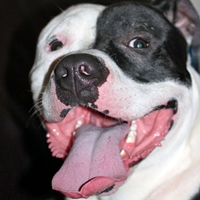 While reading dog food ingredients on the back of dog food packaging, you should try to avoid any of the following:
While reading dog food ingredients on the back of dog food packaging, you should try to avoid any of the following:
Grain
Low to moderate amounts of grain will not harm your dog and, contrary to popular belief, grains in dog food are not simply a filler and they do have some nutritional value, depending on the food and the quality of the ingredients. They are a plant-based protein and they contain anywhere from 54 to 75 percent protein, which starts to make them comparable to some of the lower kinds of meat protein. They are not as easy for dogs to digest as meat-based proteins but, used in conjunction with meat protein, they can help your dog feel full after eating and keep him from becoming immediately hungry again. You should definitely avoid foods which feature grain as one of the first ingredients, however, and choose a food that has several sources of meat protein in the first few ingredients instead. Grains do not cause allergies. Dogs can become allergic to grains, but more dogs are allergic to beef, dairy products, chicken, lamb, fish, and chicken eggs than any grains. Grains in dog food do not cause weight gain, obesity, diabetes, or other health problems in dogs. The three major veterinary-prescribed diabetic dog foods feature grains. Over feeding and lack of exercise cause weight gain and there is no evidence that grains cause any particular health problems in dogs.
Meat By-Product
Dog food grade meat by-products usually consist of undesirable parts which have been deemed unacceptable for human consumption. Meat by-products can include bones, blood, intestines, lungs, ligaments, heads, feet, and feathers. These parts may also be derived from animals which are dying, diseased, or have been dead for an extended period of time. You do not want to feed this stuff to your dog!
Meat And Bone Meal
Meat and bone meal is a very specific term and includes the slaughtering waste and parts of the animal which is not fit for human consumption. Meat and bone meal can contain any mammal. It can contain road kill, animals which are diseased, dying, disabled, or already dead. Find something with a named meat source such as chicken meal or lamb meal.
Beef Tallow
This is a very low quality fat source used to increase the taste of your dog’s food but does little to improve nutrition. You should look for high quality and naturally-derived fat sources such as poultry or chicken fat, which is naturally preserved.
Animal Fat
This is a very generic term which can mean many things. It can mean the fat source consists of restaurant grease, and/or other oils that come from any kind of animal or poultry. As stated above, look for healthy fat sources like poultry or chicken fat.
Corn (Including Wheat or Corn Gluten Meal)
Dogs can digest about 54 percent of the plant protein in corn and 60 percent in wheat. Corn is not the dreadful ingredient that some people seem to believe although you should avoid foods that rely too heavily on it. It does not “cause” allergies in dogs and it does not cause obesity. Many very good dog foods use some corn in their formulas. Gluten meals may have picked up a bad reputation because the term was used during the dog food recalls in 2007 when many pets died but this had nothing to do with the actual ingredient. Chinese manufacturers laced the gluten meal with melamine to make the product appear to have a higher protein content. Melamine is used to make plastic but chemically it reads as a protein. When the gluten meal with the melamine was used to make dog food in the United States and Canada, unbeknownst to the dog food companies, it was harmful to pets. The dog food companies were as shocked as anyone and many of them now have testing in place to make sure something like this can never happen again.
Whole Wheat Flour
Whole Wheat Flour does not cause allergies in pets. It is frequently used to make dog food snacks and cookies and it is the same ingredient that you find in many kitchens used to make bread and other baked goods for people. In fact, whole grain flours are usually considered healthier for people than other flours, so the same should presumably be true for dogs.
Food Fragments
This usually consists of low quality leftovers from some other type of food manufacturing process such as leftover waste rice which was used in the production of alcohol. You also want to avoid any labels which say potato product, middlings/mids, mill run, cereal food fines, corn bran, oat hulls, rice hulls, peanut hulls, distillers grain fermentation solubles, and cellulose (ground up wood particles). Most of these terms are rarely seen, but you will find a few of them listed in some of the more expensive foods as dog food companies get more creative in cutting corners.
Soy Flour
Soy flour does not cause allergies. No grains – or any other foods — actually “cause” allergies. In some cases a dog may become allergic to an ingredient after he has been exposed to it more than once but there are usually multiple factors which determine whether or not a dog develops an allergy such as his overall health and his immune system. Among the total canine population it’s estimated that only about 10 percent of dogs have food allergies. Soy Flour is derived from roasted soybeans that have been ground into a fine powder. The plant-protein in soy is about 75 percent digestible for your dog, making it similar to fish.
Sugar And Artificial Sweeteners
Not only do you want to avoid sugar, but you also want to avoid cane molasses, corn syrup, sorbitol, sucrose, fructose, glucose, ammoniated glycyrrhizin, propylene glycol, and xylitol. These ingredients are used to make food more palatable for dogs. They add additional calories unnecessarily and have no nutritional value. Sugars can also lead to hyperactivity, nervousness, and tooth decay.
Animal Digest
This is a pretty disgusting one. Unspecified animal parts are cooked down into a broth and sprayed onto food or sometimes mixed right in.
Coloring
Food coloring, including blue 2, red 40, yellow 5, yellow 6, and titanium dioxide should be avoided. They are unnecessary as your dog doesn’t care what size, shape, or color the food is. The coloring is added to be more appealing to the human.
Menadione Sodium Bisulfite Complex (source of Vitamin K Activity)
This is a controversial ingredient but my stance is that it should not be used in any dog food. Menadione is a synthetic man-made form of vitamin K and has been linked to toxic reactions in liver cells, a weakened immune system, allergic reactions, and other very negative side-effects. Dogs do not require much vitamin K and this ingredient is completely unnecessary in dog food according to the Association Of American Feed Control Officials. Why include an ingredient deemed unnecessary, which has also been linked to serious illnesses and side effects? I have yet to obtain a reasonable explanation about why synthetic vitamin K is used in dog food.
Hydrochloric Acid
Some dog food companies use this in their food to help dogs digest their food better. Hydrochloric Acid is produced naturally in a dog’s stomach to break down food. Any food which needs to have hydrochloric acid added in addition to what the dog naturally produces should be a clue that it’s a terrible food! Do not purchase any dog food containing hydrochloric acid.
Artificial Preservatives
BHA and BHT (butylated hydroxyanisole and butylated hydroxytoluene) are synthetic antioxidants used as preservatives that are added to many foods to prevent fat spoilage. They are banned in many countries outside the U.S. These chemicals are considered toxic in certain usages and have been linked to cancer. They are sometimes found in lower quality dog foods. You should look for foods that use natural preservatives instead, such as vitamins C and E.
Ethoxyquin
Ethoxyquin is a quinoline-based antioxidant widely used as a preservative in fish. As such, it is often found in dog foods that contain fish. If the ethoxyquin is added to the fish before it arrives at the dog food manufacturer’s facilities, they are not required to list it in the ingredients. It’s even found in many premium dog foods without consumers being aware of it. There are a few companies which go out of their way to use fish which is ethoxyquin-free and they make this clear on their web sites. If your dog food does not state that it is ethoxyquin-free, then you can assume that the fish they use contains this substance. The problem with ethoxyquin is that it has other uses besides being a preservative. It is also used as a pesticide and to make synthetic rubber tires. The FDA has found that ethoxyquin leads to a buildup of protoporphyrin IX in the liver and elevated liver-related enzymes in some animals, though the health consequences of these changes are not known. The Center for Veterinary Medicine has asked pet food manufacturers to voluntarily limit the levels of ethoxyquin in foods until there is further testing.
 I know what you’re thinking. Finding high quality dog food ingredients sounds well and good but how much does healthy dog food cost? Let me warn you now, on the surface, better dog foods usually cost more. In reality, you will be paying for better health for your dog. Feeding your dog a healthier diet that features meat protein, low to moderate carbohydrates, and high quality ingredients means you won’t have to feed as much as you would with lower quality foods. Your dog will be getting more nutrition from less food. Your dog will also feel more satisfied after his meals. You’ll also save in the long-term because your dog will be enjoying better health and you won’t be going to the vet so often. Worst case scenario, you pay slightly more over a long period of time for high quality dog food ingredients.
I know what you’re thinking. Finding high quality dog food ingredients sounds well and good but how much does healthy dog food cost? Let me warn you now, on the surface, better dog foods usually cost more. In reality, you will be paying for better health for your dog. Feeding your dog a healthier diet that features meat protein, low to moderate carbohydrates, and high quality ingredients means you won’t have to feed as much as you would with lower quality foods. Your dog will be getting more nutrition from less food. Your dog will also feel more satisfied after his meals. You’ll also save in the long-term because your dog will be enjoying better health and you won’t be going to the vet so often. Worst case scenario, you pay slightly more over a long period of time for high quality dog food ingredients.
Which Dog Food Is Best?
That’s a tough question to answer as the “best” dog food will vary since each dog is unique in their own way. However, you should look for a food that is high in meat protein and which has low to moderate carbohydrates, as well as good quality named fat. You want to have a meat-based item as the number 1 ingredient and preferably dominating the first 5 ingredients. You can also check out my detailed dog food reviews to help find the best food for your dog.
I’m personally a huge fan of Orijen Dog Food and that’s what I use for my dog. Let’s check out the ingredients, shall we? Remember, the first 5 ingredients are the most important:
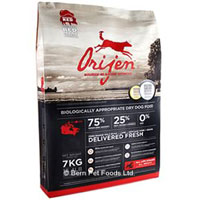 Orijen Dog Food
Orijen Dog Food
Ingredients: Fresh deboned wild boar, fresh deboned lamb, lamb meal, russet potato, fresh deboned pork, peas, salmon meal, whitefish meal, herring meal, fresh deboned bison, fresh whole eggs, potato starch, fresh deboned salmon (a natural source of DHA and EPA), alfalfa, sweet potato, fresh deboned walleye, salmon oil (naturally preserved with vitamin E), pea fiber, psyllium, pumpkin, tomatoes, carrots, apples, cranberries, Saskatoon berries, black currants, chicory root, licorice root, angelica root, fenugreek, marigold flowers, sweet fennel, peppermint leaf, chamomile flowers, dandelion, summer savory, rosemary, organic kelp, vitamin A, vitamin D3, vitamin E, niacin, zinc proteinate, thiamine mononitrate, riboflavin, vitamin B5, iron proteinate, vitamin B6, manganese proteinate, copper proteinate, folic acid, biotin, vitamin B12, selenium, dried Lactobacillus acidophilus product, dried Enterococcus faecium fermentation product
Notice the first 5 ingredients? Now let’s compare that to something like, say, Beneful Healthy Weight Formula Dog Food:
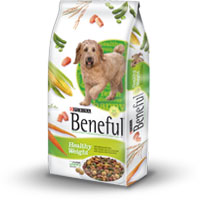
Beneful Dog Food
Ingredients: Ground yellow corn, chicken by-product meal, corn gluten meal, soybean hulls, whole wheat flour, rice flour, chicken, soy flour, beef tallow preserved with mixed-tocopherols (source of Vitamin E), sugar, animal digest, tricalcium phosphate, sorbitol, water, salt, phosphoric acid, potassium chloride, dicalcium phosphate, sorbic acid (a preservative), L-Lysine monohydrochloride, dried green beans, dried carrots, calcium carbonate, calcium propionate (a preservative), choline chloride, vitamin supplements (E, A, B-12, D-3), zinc sulfate, added color (Yellow 5, Red 40, Yellow 6, Blue 2), DL-Methionine, ferrous sulfate, gyceryl monostearate, manganese sulfate, niacin, calcium pantothenate, riboflavin supplement, biotin, thiamine mononitrate, copper sulfate, garlic oil, pyridoxine hydrochloride, folic acid, menadione sodium bisulfate complex (source of Vitamin K activity), calcium iodate, sodium selenite. *14 percent-a source of fiber
The Differences Are Clear
See the difference in the quality of ingredients being used? I don’t think it needs much explaining. With what you just read on this page, you now have the knowledge necessary to quickly check labels on dog food and find a quality brand which will lead to a healthier and happier dog as well as reduced veterinary expenses!

Wow, great article. Thank you for informing us of exactly what we are feeding our dogs. Now I know what to look for on the label.
Nicely written, well-researched article. The only thing I had an issue with is the “presumption” that since whole wheat is good for people it’s good for dogs. It’s not safe to make that presumption. We can look at people foods like chocolate, or animal foods that are unsafe for humans and safe for dogs to see that that presumption is not true. Other than that I was impressed with the information you provided and appreciate the research you put forth!
I have used Orijjen for 6 of my 10 dogs I have raised.(since I found out about it) Initially I had it shipped from Alberta, now it can be purchased in Ontario. Vets have always commented on their heath being excellent. fortunately none of them had any serious or really any minor illnesses . This dog food is well worth the money and we both couldn’t be happier with this dog food.